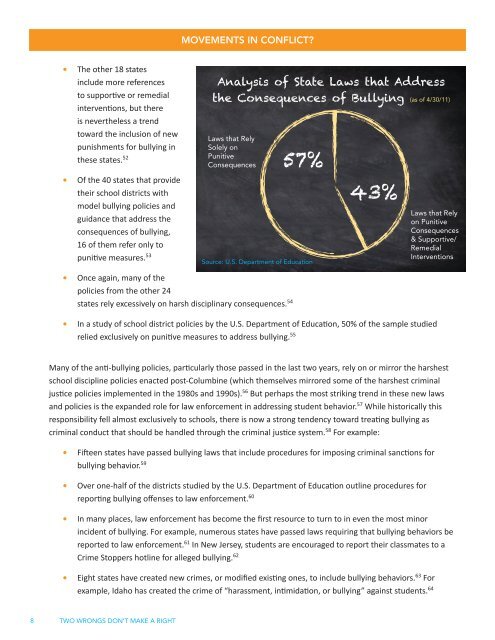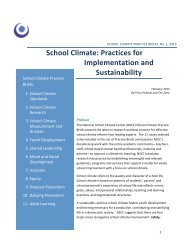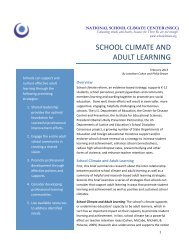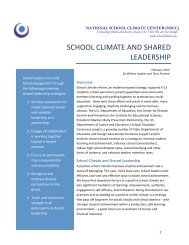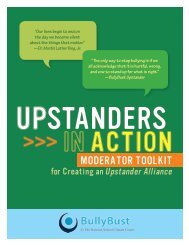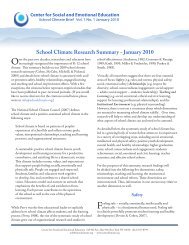two wrongs don't make a right - National School Climate Center
two wrongs don't make a right - National School Climate Center
two wrongs don't make a right - National School Climate Center
You also want an ePaper? Increase the reach of your titles
YUMPU automatically turns print PDFs into web optimized ePapers that Google loves.
MOVEMENTS IN CONFLICT?<br />
• The other 18 states<br />
include more references<br />
to supportive or remedial<br />
interventions, but there<br />
is nevertheless a trend<br />
toward the inclusion of new<br />
punishments for bullying in<br />
these states. 52<br />
• Of the 40 states that provide<br />
their school districts with<br />
model bullying policies and<br />
guidance that address the<br />
consequences of bullying,<br />
16 of them refer only to<br />
punitive measures. 53<br />
Analysis of State Laws that Address<br />
the Consequences of Bullying (as of 4/30/11)<br />
Laws that Rely<br />
Solely on<br />
Punitive<br />
Consequences<br />
57%<br />
Source: U.S. Department of Education<br />
43%<br />
Laws that Rely<br />
on Punitive<br />
Consequences<br />
& Supportive/<br />
Remedial<br />
Interventions<br />
• Once again, many of the<br />
policies from the other 24<br />
states rely excessively on harsh disciplinary consequences. 54<br />
• In a study of school district policies by the U.S. Department of Education, 50% of the sample studied<br />
relied exclusively on punitive measures to address bullying. 55<br />
Many of the anti-bullying policies, particularly those passed in the last <strong>two</strong> years, rely on or mirror the harshest<br />
school discipline policies enacted post-Columbine (which themselves mirrored some of the harshest criminal<br />
justice policies implemented in the 1980s and 1990s). 56 But perhaps the most striking trend in these new laws<br />
and policies is the expanded role for law enforcement in addressing student behavior. 57 While historically this<br />
responsibility fell almost exclusively to schools, there is now a strong tendency toward treating bullying as<br />
criminal conduct that should be handled through the criminal justice system. 58 For example:<br />
• Fifteen states have passed bullying laws that include procedures for imposing criminal sanctions for<br />
bullying behavior. 59<br />
• Over one-half of the districts studied by the U.S. Department of Education outline procedures for<br />
reporting bullying offenses to law enforcement. 60<br />
• In many places, law enforcement has become the first resource to turn to in even the most minor<br />
incident of bullying. For example, numerous states have passed laws requiring that bullying behaviors be<br />
reported to law enforcement. 61 In New Jersey, students are encouraged to report their classmates to a<br />
Crime Stoppers hotline for alleged bullying. 62<br />
• Eight states have created new crimes, or modified existing ones, to include bullying behaviors. 63 For<br />
example, Idaho has created the crime of “harassment, intimidation, or bullying” against students. 64<br />
8 TWO WRONGS DON’T MAKE A RIGHT


